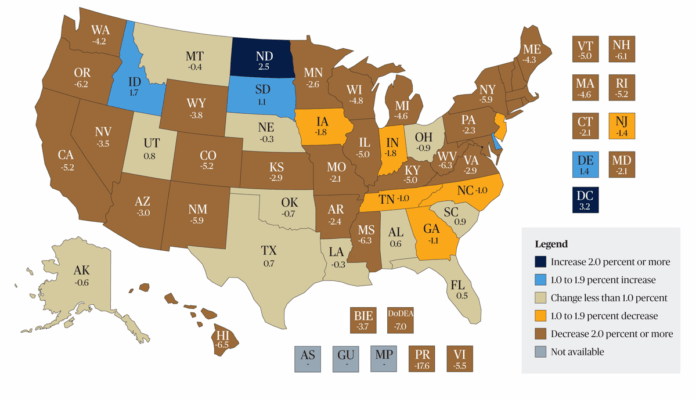Across the country, public school enrollment has failed to rebound to pre-pandemic levels — and data suggests the decline is far from over.
According to projections from the National Center for Education Statistics, public K-12 enrollment peaked at 50.8 million students in autumn 2019, but is expected to fall by nearly 4 million students to 46.9 million by 2031, a 7.6% nationwide drop.
The steepest enrollment losses are in elementary and middle grades, with districts in the Northeast, West and Rust Belt most affected. When public school enrollment fell by 3% in 2020, it was the largest single-year decline since World War II.
The NCES 2024 December report, which accounts for fall 2023 data, found that 18 states saw public school enrollment declines of more than 4%. Ten states — California, Colorado, Hawaii, Mississippi, New Hampshire, New Mexico, New York, Oregon, Rhode Island and West Virginia declined more than 5%.
A new study from Boston University found that high-income districts and middle schools in Massachusetts were especially vulnerable, with middle grade enrollment in fall of 2024 down almost 8% and the most significant losses concentrated among white and Asian students.
Public school enrollment in Massachusetts was down 2% from pre-pandemic trends for the fall 2024 school year, while private school enrollment rose 14% and homeschooling surged 45%.
Long-term demographic shifts — such as falling birth rates, domestic migration and a post-COVID shift toward school choice — are also a factor in public school enrollment declines. Parents increasingly opt for private, charter or homeschooling models — options that expanded rapidly during and after the pandemic.
A February Gallup poll showed that dissatisfaction with the U.S. public education system is rising, with the percentage of adults who report feeling satisfied about public education falling from 37% to 24% between 2017 and 2025.
The National Alliance for Public Charter Schools reported a net gain of 400,000 students over five years, offsetting some of the 1.8 million student losses from traditional districts.
Public school funding, often tied to enrollment, is also shrinking. According to the Reason Foundation, 98 public schools closed in 2023-24 across 15 states, with significant losses in California, Colorado, Florida and New York. Districts are facing tough decisions around school consolidations, staffing and infrastructure.
ProPublica reported that shrinking enrollment left roughly 150 Chicago schools operating at half-capacity this past school year, with another 47 at one-third capacity.
However, some researchers offer a more nuanced view. A Kennesaw State University researcher notes that declining enrollment can lead to higher per-student funding. Since districts often retain funding for students who’ve left, those resources can be reallocated to support remaining students, improving staff compensation and access to teachers and other support services.
This story originally appeared in Stateline, which is, like the Virginia Mercury, part of States Newsroom.
NEWSLETTER SIGNUP
Subscribe to our newsletter! Get updates on all the latest news in Virginia.



